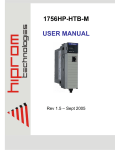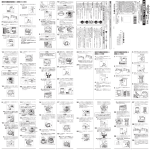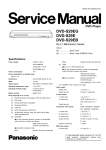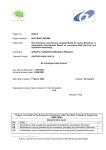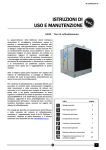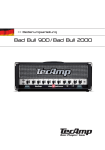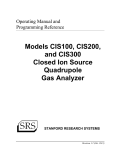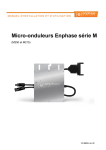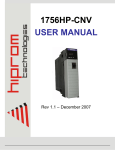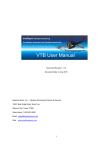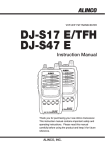Download 1756HP-HTB-S USER MANUAL
Transcript
1756HP-HTB-S I/O SLAVE USER MANUAL Rev 1.4 – September 2005 1756HP-HTB-S - User Manual Rev 1.4 Table of Contents Chapter 1 Chapter 2 Chapter 3 Chapter 4 Chapter 5 Chapter 6 Appendix A Appendix B Appendix C Appendix D Introduction.......................................................................................................3 Module Accessories .........................................................................................4 Module Operation.............................................................................................4 Installing the Module ........................................................................................5 Configuring the Module ....................................................................................6 I/O Address Map ............................................................................................10 Overview of hisec IO network ........................................................................13 modulestatus ..................................................................................................14 Recommended Data Structures.....................................................................15 Specifications .................................................................................................16 . Page 2 of 16 1756HP-HTB-S - User Manual Rev 1.4 CHAPTER 1 INTRODUCTION Hiprom presents the 1756HP-HTB-S Hitachi interface module. The 1756HP-HTB-S and the 1756HP-HTB-M 1 modules together provide an interface between existing Hitachi control systems and new Allen Bradley ControlLogix PLC’s. The 1756HP-HTB-S (slave) module is able to emulate an entire I/O network, satisfying the Hitachi CPU’s required connection to I/O. Reference can be made to Appendix A which details the HISEC IO network. The module fits directly into any single slot within a ControlLogix System and is configured in RSLogix5000 using the Generic Profile. A Brad Harrison Nano-Change (M8) Receptacle provides a physical connection for the Hitachi signaling. This document serves to describe the functionality, installation, configuration and use of the module. 1 Reference can be made to the 1756HP-HTB-M User Manual for detailed information regarding this manual . Page 3 of 16 1756HP-HTB-S - User Manual Rev 1.4 CHAPTER 2 MODULE ACCESSORIES Each 1756HP-HTB-S package includes the following components: • • 1756HP-HTB-S module 2m Patch lead CHAPTER 3 MODULE OPERATION The 1756HP-HTB-S module is designed to operate within the Allen-Bradley ControlLogix PLC system. All power required for the module’s operation is derived from the 1756 backplane. Alphanumeric Display Status LEDs Reserved RJ45 Port Brad Harrison Nano-Change (Hitachi Interface) Figure 3.1 : 1756HP-HTB-S Layout . Page 4 of 16 1756HP-HTB-S - User Manual Rev 1.4 The current status of the module is conveyed to the user by means of the 3 bi-color Status LED’s and the alphanumeric LED display. Appendix B details the various states of the LEDs and messages of alphanumeric display. The following information is available to the user directly across the backplane by means of a scheduled connection: • • Hitachi I/O data (for a slot configured as an input module) Hitachi slot status information. The Brad Harrison Nano-Change Receptacle located on the bottom of the module provides an external connection for the Hitachi interface. The board is accompanied with the respective 2m five core patch cable, of which the Hitachi cables are white and black. CHAPTER 4 INSTALLING THE MODULE The module is equipped with RIUP (Removal and Insertion Under Power) circuitry enabling the module to be installed or removed from the chassis while power is applied. . Page 5 of 16 1756HP-HTB-S - User Manual Rev 1.4 CHAPTER 5 CONFIGURING THE MODULE A direct connection between the controller and the 1756HP-HTB-S module is required to transfer I/O data to and from the module. 5.1. Establishing the Direct Connection This section describes the procedures necessary to configure the 1756HP-HTB-S module within the ControlLogix system. Each 1756HP-HTB-S module must be owned by a single ControlLogix controller. The 1756 Generic Module is used in RSLogix5000 to configure the module. The configuration of the module is detailed in the table below. CommFormat Description Input Output Configuration Min Data Format Data – DINT Connection parameters Instance 1 2 4 RPI 5 msec Max Size 32 (32 Bit) 32 (32 Bit) 12 (8 Bit) 750.0 msec Table 5.1 : 1756HP-HTB-S connection parameters. The steps required to add a new 1756HP-HTB-S module are detailed below. Figure 5.1 : Right-click on I/O Configuration and select New Module . Page 6 of 16 1756HP-HTB-S - User Manual Rev 1.4 Figure 5.2: Select Generic 1756 Module (1756-MODULE ) Figure 5.3: Configure module’s parameters . Page 7 of 16 1756HP-HTB-S - User Manual Rev 1.4 Figure 5.4: Configure module’s RPI (Requested Packet Interval) Before a connection is established between the 1756HP-HTB-S module and a ControlLogix processor, the Configuration data must be setup. The configuration data specifies the • Enabled Hitachi I/O slots and direction as either an output or input • Low, medium and high diagnostic thresholds. The format of the configuration data is illustrated below. BIT BYTE 0 1 2 3 S7E S15E S23E S31E 4 5 6 7 IO7 IO15 IO23 IO31 8 9 10 11 7 6 5 4 3 2 1 I/0 Enable S6E S5E S4E S3E S2E S1E S14E S13E S12E S11E S10E S9E S22E S21E S20E S19E S18E S17E S30E S29E S28E S27E S26E S25E Input / Output IO6 IO5 IO4 IO3 IO2 IO1 IO14 IO13 IO12 IO11 IO10 IO9 IO22 IO21 IO20 IO19 IO18 IO17 IO30 IO29 IO28 IO27 IO26 IO25 Diagnostic Threshold levels Low Threshold Medium Threshold High Threshold Reserved 0 S0E S8E S16E S24E IO0 IO8 IO16 IO24 The first 4 bytes (SnE where n = Extended Slot number) of the Configuration Image indicate the Hitachi enabled slots. “1” = Enabled, “0” = Disabled . Page 8 of 16 1756HP-HTB-S - User Manual Rev 1.4 The next four bytes (IOn where n = Extended Slot number) of the Configuration Image specify whether the enabled slots are either of type Input or Output: “1” = Output “0” = Input Note: The 1756HP-HTB-M can only support 30 slots (i.e 0..29) The remaining fields to be configured are those of the threshold levels. The module continuously records the number of successful transactions for each enabled slot within a specific time frame. The thresholds levels that are specified within the configuration file create ranges as illustrated below that are then used for diagnostic display purposes (refer to Appendix B). Threshold Levels X Counts (Network Dependent) High Medium Low 0% Once a module’s configuration data has been downloaded to the controller, it will establish a connection with the module. Should the configuration of the 1756HP-HTB-S change, the module will need to be reset. A connection will fail if there is inappropriate configuration data, this includes: • • • The specified size of the Input, Output, or Configuration size is incorrect The assembly instance of the input, Output and Configuration is incorrect An RPI that does not fall within the specified range The module utilizes a system watchdog to ensure the integrity of the connection to the controller, refer to the Output Image. . Page 9 of 16 1756HP-HTB-S - User Manual Rev 1.4 CHAPTER 6 I/O ADDRESS MAP The input and output image of the 1756HP-HTB-S module is defined in the following sections. 6.1. Input Image Figure 6.1 : Connected Input Image 6.2. Field/Value Data Enabled Input Image Description Description Output Data If module is configured as an output this field reflects the current data of the associated output Hitachi slot. If the associated Hitachi slot is configured as an input, the data will display 0x0000 Slot Enable 0 = Hitachi Slot not enabled 1 = Hitachi Slot is enabled Direction Slot type: Indicates the direction / type of module located in the associated slot 0 = Input module 1 = Output module Status Module status: Should the module in the associated slot be enabled this bit indicates the current status of that module 1 = Associated slot is operating correctly 0 = Associated slot has faulted. One can refer to the Timeoutand Transcount for further details. Location Type Local:s:I.Data[n].0..15 INT Local:s:I.Data[n].16 BIT Local:s:I.Data[n].17 BIT Local:s:I.Data[n].18 BIT . Page 10 of 16 1756HP-HTB-S - User Manual Rev 1.4 Timeout bit: Indicates that a response was not received from the associated slot within a specific timeframe. 1 = No fault, data received 0 = No response was received from the associated slot Timeout Transcount Count of successful transactions with the respective extended slot within a given time frame. Local:s:I.Data[n].19 Local:s:I.Data[n].24..31 BIT SINT Warning: It is important to ensure that the diagnostic status information is used in the PLC logic in order to detect possible module or network failure. Failing to do so could result in possible equipment damage or personal injury 6.3. Output Image Words 0..29 Should a slot be configured as an input, the respective output word will read the input data. The card uses this data to emulate the input network, satisfying the Hitachi CPU’s connection to the network. Thus, assuming slot 6 of the Hitachi network has been configured as a Hitachi input card, the data corresponding to the slot can be written to Local:s:O.Data[6]. Field Output Data Description Input data to be written to a Hitachi CPU. Location Type Local:s:O.Data[n]0..15 INT . Page 11 of 16 1756HP-HTB-S - User Manual Rev 1.4 Word 30 WatchDog Word 30 (Local:s:O.Data[30]) of the output image is reserved for a watchdog. The watchdog ensures that the connection with the controller has been established and continues to remain connected, thus ensuring that no inaccurate data can be written/read to/from the Hitachi network. The watchdog is an integer (word) that must be changed within every 10ms. Should the value not change the module will fault and this will be indicated via the alphanumeric display and LED statuses. Transactions with the Hitachi Network will terminate when the watchdog has faulted, and resume once the watchdog begins updating again. . Page 12 of 16 1756HP-HTB-S - User Manual Rev 1.4 APPENDIX A OVERVIEW OF HISEC IO NETWORK Network Topology The Hitachi HISEC I/O network is a single master, multiple slave network connected by means of a multi-dropped single pair of wires. The master, typically an H02 CPU or a CE module connected to an H04 CPU, is responsible for interrogating (inputs) and commanding (outputs) on each logical slot on the network. Each slot is processed in logical slot ascending order although the protocol does not require this. That is, slot 0 is processed, then slot 1, and so on. After slot 31 has been processed it rolls over to slot 0 and the sequence is repeated. The logical slot number (0-31), also referred to as the extended slot number, is the unique slot address on the network. For the first rack on the network, (station address zero), it is simply the physical slot number, numbering from 0 ( on the left) to n-1 (on the right), where n is the number of logical slots in the physical rack. For subsequent racks, where the rack station address is greater than zero the extended slot number can be calculated as follows : Extended Slot = ( ST * 2 ) + y Where : ST = station address as configured by the ST dial on the rack controller (PST360) module, y = physical slot number ( 0 through n – 1, where n is the logical rack size ) The network does not differentiate on how the logical address is determined. For example, the modules in one 8 slot rack (with ST = 0), are addressed in the exact same manner in which two 4 slot racks ( with ST = 0 and ST = 2 respectively) are addressed. . Page 13 of 16 1756HP-HTB-S - User Manual Rev 1.4 MODULESTATUS APPENDIX B The following sections describe the status indicators of the module : Status LEDs LED DESCRIPTION OK Module Status Enabled Slots ACT COM 6.4. Init Frn WDog nn33 Nn 3 nn X nnXX All Slots OK STATUS Solid Red Flashing Red Flashing Green Green Solid Red Green Solid Green Solid Red MEANING Initialization or Watch Dog Fault Major Fault Minor Fault Module operating correctly Watchdog Error or No slots enabled Slots Enabled with no watchdog error All enabled slots communication operating correctly A timeout has occurred for the update time for one or more of the enabled slots Status Display Initialization of Module The module is initialized only on power-up. Firmware Revision The firmware revision number is displayed on power-up. WatchDog Watchdog fault Successful Transactions between High threshold and 100% (nn = Extended slot) Successful Transactions between Meduim and High threshold (nn = Extended slot) Successful Transactions between Low and Medium threshold (nn = Extended slot) Successful Transactions between 0% and Low threshold (nn = Extended slot) . Page 14 of 16 1756HP-HTB-S - User Manual Rev 1.4 APPENDIX C RECOMMENDED DATA STRUCTURES This Appendix provides a detailed description of recommended data structures that can be used. Name EnableSlot TypeSlot ThresholdLow ThresholdMed ThresholdHigh Datatype BOOL[32] BOOL[32] SINT SINT SINT Style Decimal Decimal Decimal Decimal Decimal Table D.1: Slave Module Configuration Data Structure Name InputData Enabled Direction Status TimeOut Reserved0 Reserved1 Reserved2 Reserved3 TransCount Datatype INT BOOL BOOL BOOL BOOL BOOL BOOL BOOL BOOL SINT Style Decimal Decimal Decimal Decimal Decimal Decimal Decimal Decimal Decimal Decimal Table D.2: Slave Module Input Image Word Structure Name Data Reserved DataType INT INT Style Decimal Decimal Table D.3: Slave Module Output Image Word Structure . Page 15 of 16 1756HP-HTB-S - User Manual Rev 1.4 APPENDIX D SPECIFICATIONS Parameter Specification General Module Location Backplane Current RPI Any Slot Electrical 515mA @ 5.1V 3mA @ 24V Schedules Connection Parameters 5ms to 750ms . Page 16 of 16
















